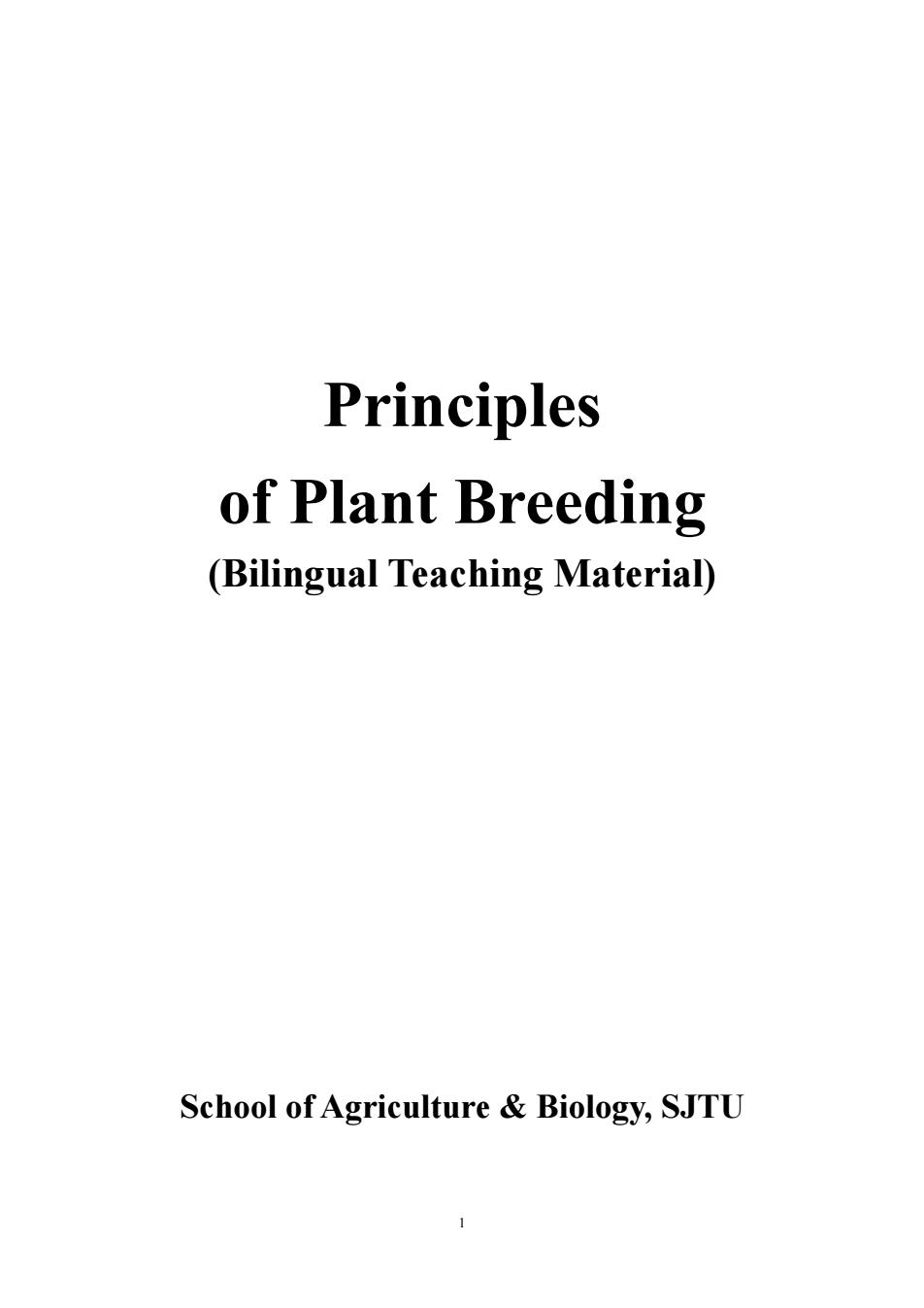
Principles of Plant Breeding (Bilingual Teaching Material) School of Agriculture Biology,SJTU
1 Principles of Plant Breeding (Bilingual Teaching Material) School of Agriculture & Biology, SJTU
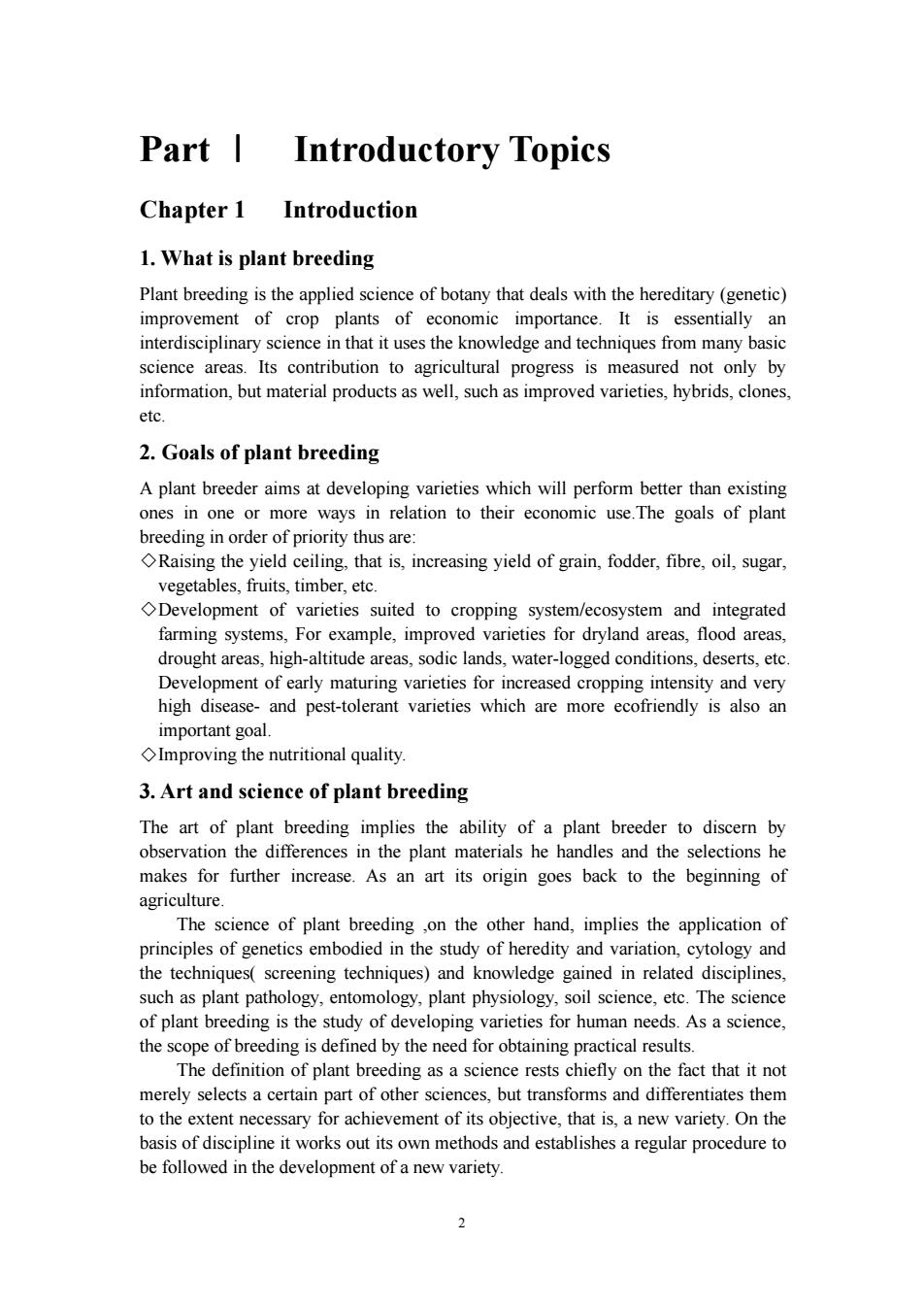
Part Introductory Topics Chapter 1 Introduction 1.What is plant breeding Plant breeding is the applied science of botany that deals with the hereditary(genetic) improvement of crop plants of economic importance.It is essentially an interdisciplinary science in that it uses the knowledge and techniques from many basic science areas.Its contribution to agricultural progress is measured not only by information,but material products as well,such as improved varieties,hybrids,clones, etc. 2.Goals of plant breeding A plant breeder aims at developing varieties which will perform better than existing ones in one or more ways in relation to their economic use.The goals of plant breeding in order of priority thus are: Raising the yield ceiling,that is,increasing yield of grain,fodder,fibre,oil,sugar, vegetables,fruits,timber,etc. Development of varieties suited to cropping system/ecosystem and integrated farming systems,For example,improved varieties for dryland areas,flood areas, drought areas,high-altitude areas,sodic lands,water-logged conditions,deserts,etc Development of early maturing varieties for increased cropping intensity and very high disease-and pest-tolerant varieties which are more ecofriendly is also an important goal. Improving the nutritional quality. 3.Art and science of plant breeding The art of plant breeding implies the ability of a plant breeder to discern by observation the differences in the plant materials he handles and the selections he makes for further increase.As an art its origin goes back to the beginning of agriculture. The science of plant breeding,on the other hand,implies the application of principles of genetics embodied in the study of heredity and variation,cytology and the techniques(screening techniques)and knowledge gained in related disciplines, such as plant pathology,entomology,plant physiology,soil science,etc.The science of plant breeding is the study of developing varieties for human needs.As a science, the scope of breeding is defined by the need for obtaining practical results. The definition of plant breeding as a science rests chiefly on the fact that it not merely selects a certain part of other sciences,but transforms and differentiates them to the extent necessary for achievement of its objective,that is,a new variety.On the basis of discipline it works out its own methods and establishes a regular procedure to be followed in the development of a new variety. 2
2 Part Ⅰ Introductory Topics Chapter 1 Introduction 1. What is plant breeding Plant breeding is the applied science of botany that deals with the hereditary (genetic) improvement of crop plants of economic importance. It is essentially an interdisciplinary science in that it uses the knowledge and techniques from many basic science areas. Its contribution to agricultural progress is measured not only by information, but material products as well, such as improved varieties, hybrids, clones, etc. 2. Goals of plant breeding A plant breeder aims at developing varieties which will perform better than existing ones in one or more ways in relation to their economic use.The goals of plant breeding in order of priority thus are: ◇Raising the yield ceiling, that is, increasing yield of grain, fodder, fibre, oil, sugar, vegetables, fruits, timber, etc. ◇Development of varieties suited to cropping system/ecosystem and integrated farming systems, For example, improved varieties for dryland areas, flood areas, drought areas, high-altitude areas, sodic lands, water-logged conditions, deserts, etc. Development of early maturing varieties for increased cropping intensity and very high disease- and pest-tolerant varieties which are more ecofriendly is also an important goal. ◇Improving the nutritional quality. 3. Art and science of plant breeding The art of plant breeding implies the ability of a plant breeder to discern by observation the differences in the plant materials he handles and the selections he makes for further increase. As an art its origin goes back to the beginning of agriculture. The science of plant breeding ,on the other hand, implies the application of principles of genetics embodied in the study of heredity and variation, cytology and the techniques( screening techniques) and knowledge gained in related disciplines, such as plant pathology, entomology, plant physiology, soil science, etc. The science of plant breeding is the study of developing varieties for human needs. As a science, the scope of breeding is defined by the need for obtaining practical results. The definition of plant breeding as a science rests chiefly on the fact that it not merely selects a certain part of other sciences, but transforms and differentiates them to the extent necessary for achievement of its objective, that is, a new variety. On the basis of discipline it works out its own methods and establishes a regular procedure to be followed in the development of a new variety
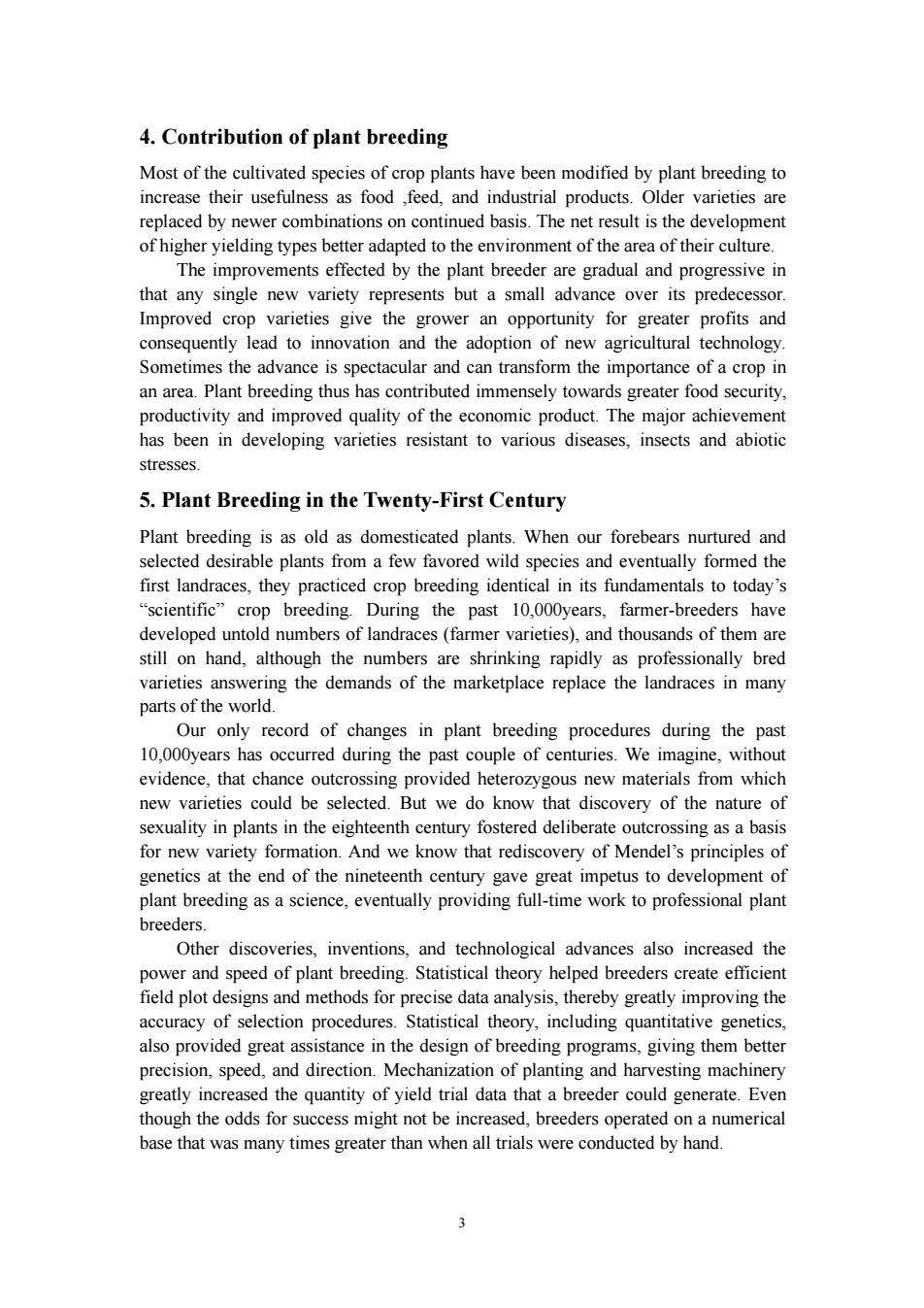
4.Contribution of plant breeding Most of the cultivated species of crop plants have been modified by plant breeding to increase their usefulness as food ,feed,and industrial products.Older varieties are replaced by newer combinations on continued basis.The net result is the development of higher yielding types better adapted to the environment of the area of their culture. The improvements effected by the plant breeder are gradual and progressive in that any single new variety represents but a small advance over its predecessor. Improved crop varieties give the grower an opportunity for greater profits and consequently lead to innovation and the adoption of new agricultural technology. Sometimes the advance is spectacular and can transform the importance of a crop in an area.Plant breeding thus has contributed immensely towards greater food security, productivity and improved quality of the economic product.The major achievement has been in developing varieties resistant to various diseases,insects and abiotic stresses. 5.Plant Breeding in the Twenty-First Century Plant breeding is as old as domesticated plants.When our forebears nurtured and selected desirable plants from a few favored wild species and eventually formed the first landraces,they practiced crop breeding identical in its fundamentals to today's "scientific"crop breeding.During the past 10,000years,farmer-breeders have developed untold numbers of landraces(farmer varieties),and thousands of them are still on hand,although the numbers are shrinking rapidly as professionally bred varieties answering the demands of the marketplace replace the landraces in many parts of the world. Our only record of changes in plant breeding procedures during the past 10,000years has occurred during the past couple of centuries.We imagine,without evidence,that chance outcrossing provided heterozygous new materials from which new varieties could be selected.But we do know that discovery of the nature of sexuality in plants in the eighteenth century fostered deliberate outcrossing as a basis for new variety formation.And we know that rediscovery of Mendel's principles of genetics at the end of the nineteenth century gave great impetus to development of plant breeding as a science,eventually providing full-time work to professional plant breeders. Other discoveries,inventions,and technological advances also increased the power and speed of plant breeding.Statistical theory helped breeders create efficient field plot designs and methods for precise data analysis,thereby greatly improving the accuracy of selection procedures.Statistical theory,including quantitative genetics, also provided great assistance in the design of breeding programs,giving them better precision,speed,and direction.Mechanization of planting and harvesting machinery greatly increased the quantity of yield trial data that a breeder could generate.Even though the odds for success might not be increased,breeders operated on a numerical base that was many times greater than when all trials were conducted by hand
3 4. Contribution of plant breeding Most of the cultivated species of crop plants have been modified by plant breeding to increase their usefulness as food ,feed, and industrial products. Older varieties are replaced by newer combinations on continued basis. The net result is the development of higher yielding types better adapted to the environment of the area of their culture. The improvements effected by the plant breeder are gradual and progressive in that any single new variety represents but a small advance over its predecessor. Improved crop varieties give the grower an opportunity for greater profits and consequently lead to innovation and the adoption of new agricultural technology. Sometimes the advance is spectacular and can transform the importance of a crop in an area. Plant breeding thus has contributed immensely towards greater food security, productivity and improved quality of the economic product. The major achievement has been in developing varieties resistant to various diseases, insects and abiotic stresses. 5. Plant Breeding in the Twenty-First Century Plant breeding is as old as domesticated plants. When our forebears nurtured and selected desirable plants from a few favored wild species and eventually formed the first landraces, they practiced crop breeding identical in its fundamentals to today’s “scientific” crop breeding. During the past 10,000years, farmer-breeders have developed untold numbers of landraces (farmer varieties), and thousands of them are still on hand, although the numbers are shrinking rapidly as professionally bred varieties answering the demands of the marketplace replace the landraces in many parts of the world. Our only record of changes in plant breeding procedures during the past 10,000years has occurred during the past couple of centuries. We imagine, without evidence, that chance outcrossing provided heterozygous new materials from which new varieties could be selected. But we do know that discovery of the nature of sexuality in plants in the eighteenth century fostered deliberate outcrossing as a basis for new variety formation. And we know that rediscovery of Mendel’s principles of genetics at the end of the nineteenth century gave great impetus to development of plant breeding as a science, eventually providing full-time work to professional plant breeders. Other discoveries, inventions, and technological advances also increased the power and speed of plant breeding. Statistical theory helped breeders create efficient field plot designs and methods for precise data analysis, thereby greatly improving the accuracy of selection procedures. Statistical theory, including quantitative genetics, also provided great assistance in the design of breeding programs, giving them better precision, speed, and direction. Mechanization of planting and harvesting machinery greatly increased the quantity of yield trial data that a breeder could generate. Even though the odds for success might not be increased, breeders operated on a numerical base that was many times greater than when all trials were conducted by hand
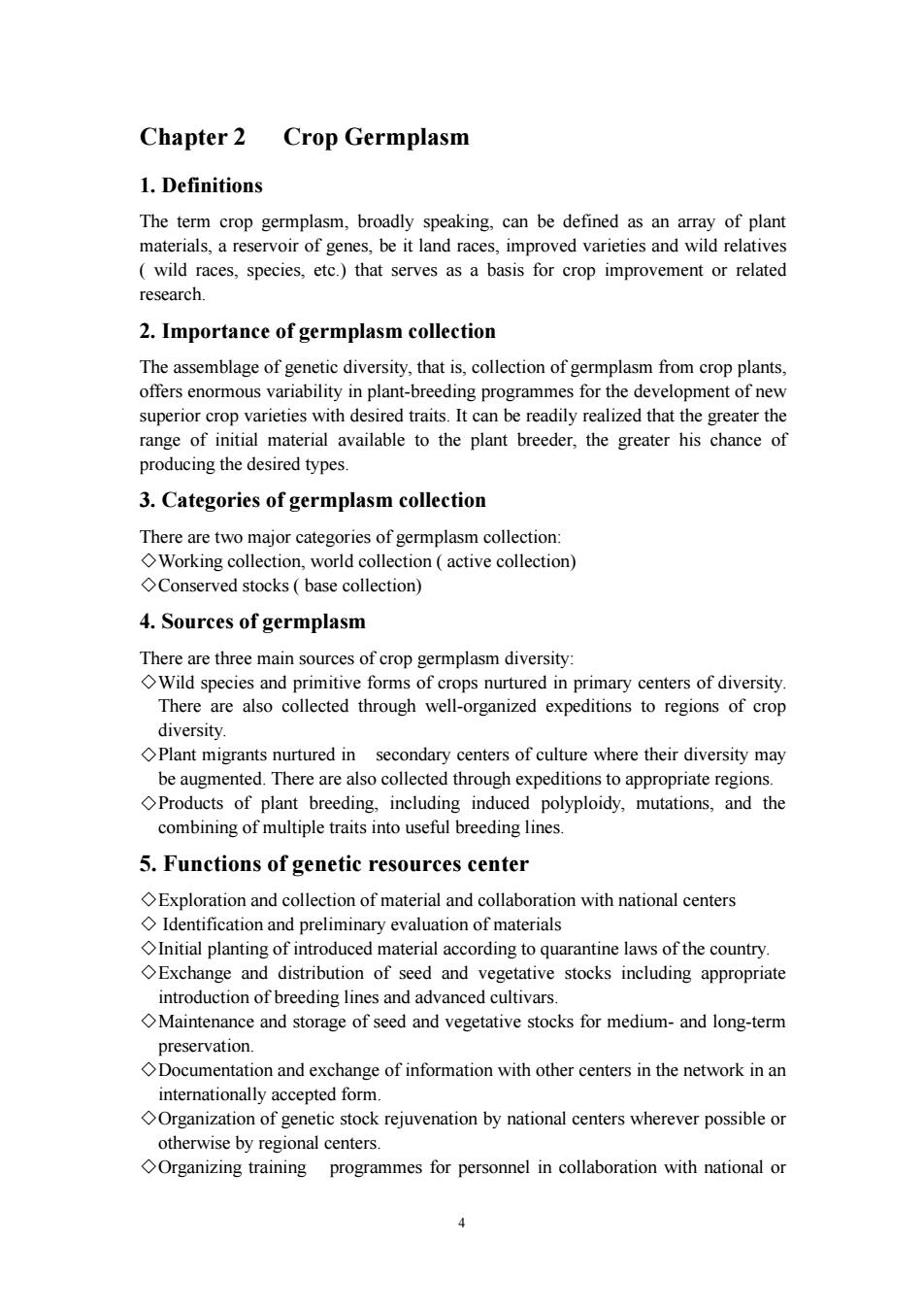
Chapter 2 Crop Germplasm 1.Definitions The term crop germplasm,broadly speaking,can be defined as an array of plant materials,a reservoir of genes,be it land races,improved varieties and wild relatives (wild races,species,ete.)that serves as a basis for crop improvement or related research. 2.Importance of germplasm collection The assemblage of genetic diversity,that is,collection of germplasm from crop plants, offers enormous variability in plant-breeding programmes for the development of new superior crop varieties with desired traits.It can be readily realized that the greater the range of initial material available to the plant breeder,the greater his chance of producing the desired types. 3.Categories of germplasm collection There are two major categories of germplasm collection: Working collection,world collection active collection) Conserved stocks base collection) 4.Sources of germplasm There are three main sources of crop germplasm diversity: Wild species and primitive forms of crops nurtured in primary centers of diversity. There are also collected through well-organized expeditions to regions of crop diversity. Plant migrants nurtured in secondary centers of culture where their diversity may be augmented.There are also collected through expeditions to appropriate regions. Products of plant breeding,including induced polyploidy,mutations,and the combining of multiple traits into useful breeding lines. 5.Functions of genetic resources center Exploration and collection of material and collaboration with national centers Identification and preliminary evaluation of materials Initial planting of introduced material according to quarantine laws of the country. Exchange and distribution of seed and vegetative stocks including appropriate introduction of breeding lines and advanced cultivars. Maintenance and storage of seed and vegetative stocks for medium-and long-term preservation. Documentation and exchange of information with other centers in the network in an internationally accepted form. Organization of genetic stock rejuvenation by national centers wherever possible or otherwise by regional centers. Organizing training programmes for personnel in collaboration with national or
4 Chapter 2 Crop Germplasm 1. Definitions The term crop germplasm, broadly speaking, can be defined as an array of plant materials, a reservoir of genes, be it land races, improved varieties and wild relatives ( wild races, species, etc.) that serves as a basis for crop improvement or related research. 2. Importance of germplasm collection The assemblage of genetic diversity, that is, collection of germplasm from crop plants, offers enormous variability in plant-breeding programmes for the development of new superior crop varieties with desired traits. It can be readily realized that the greater the range of initial material available to the plant breeder, the greater his chance of producing the desired types. 3. Categories of germplasm collection There are two major categories of germplasm collection: ◇Working collection, world collection ( active collection) ◇Conserved stocks ( base collection) 4. Sources of germplasm There are three main sources of crop germplasm diversity: ◇Wild species and primitive forms of crops nurtured in primary centers of diversity. There are also collected through well-organized expeditions to regions of crop diversity. ◇Plant migrants nurtured in secondary centers of culture where their diversity may be augmented. There are also collected through expeditions to appropriate regions. ◇Products of plant breeding, including induced polyploidy, mutations, and the combining of multiple traits into useful breeding lines. 5. Functions of genetic resources center ◇Exploration and collection of material and collaboration with national centers ◇ Identification and preliminary evaluation of materials ◇Initial planting of introduced material according to quarantine laws of the country. ◇Exchange and distribution of seed and vegetative stocks including appropriate introduction of breeding lines and advanced cultivars. ◇Maintenance and storage of seed and vegetative stocks for medium- and long-term preservation. ◇Documentation and exchange of information with other centers in the network in an internationally accepted form. ◇Organization of genetic stock rejuvenation by national centers wherever possible or otherwise by regional centers. ◇Organizing training programmes for personnel in collaboration with national or
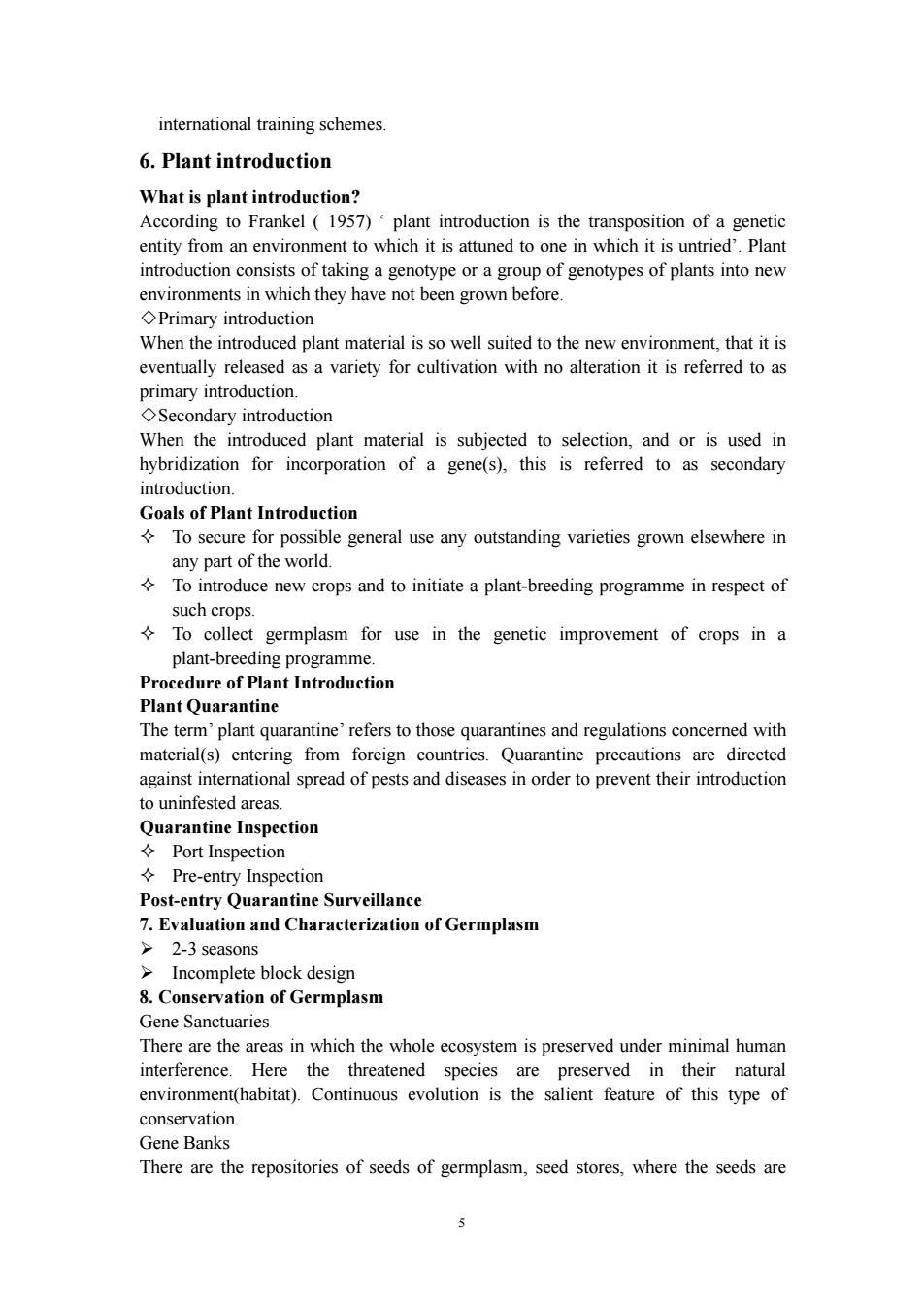
international training schemes. 6.Plant introduction What is plant introduction? According to Frankel 1957)plant introduction is the transposition of a genetic entity from an environment to which it is attuned to one in which it is untried'.Plant introduction consists of taking a genotype or a group of genotypes of plants into new environments in which they have not been grown before. Primary introduction When the introduced plant material is so well suited to the new environment,that it is eventually released as a variety for cultivation with no alteration it is referred to as primary introduction. Secondary introduction When the introduced plant material is subjected to selection,and or is used in hybridization for incorporation of a gene(s),this is referred to as secondary introduction. Goals of Plant Introduction To secure for possible general use any outstanding varieties grown elsewhere in any part of the world. To introduce new crops and to initiate a plant-breeding programme in respect of such crops. To collect germplasm for use in the genetic improvement of crops in a plant-breeding programme. Procedure of Plant Introduction Plant Quarantine The term'plant quarantine'refers to those quarantines and regulations concerned with material(s)entering from foreign countries.Quarantine precautions are directed against international spread of pests and diseases in order to prevent their introduction to uninfested areas. Quarantine Inspection ◇Port Inspection ◇Pre-entry Inspection Post-entry Quarantine Surveillance 7.Evaluation and Characterization of Germplasm >2-3 seasons >Incomplete block design 8.Conservation of Germplasm Gene Sanctuaries There are the areas in which the whole ecosystem is preserved under minimal human interference.Here the threatened species are preserved in their natural environment(habitat).Continuous evolution is the salient feature of this type of conservation Gene Banks There are the repositories of seeds of germplasm,seed stores,where the seeds are
5 international training schemes. 6. Plant introduction What is plant introduction? According to Frankel ( 1957) ‘ plant introduction is the transposition of a genetic entity from an environment to which it is attuned to one in which it is untried’. Plant introduction consists of taking a genotype or a group of genotypes of plants into new environments in which they have not been grown before. ◇Primary introduction When the introduced plant material is so well suited to the new environment, that it is eventually released as a variety for cultivation with no alteration it is referred to as primary introduction. ◇Secondary introduction When the introduced plant material is subjected to selection, and or is used in hybridization for incorporation of a gene(s), this is referred to as secondary introduction. Goals of Plant Introduction To secure for possible general use any outstanding varieties grown elsewhere in any part of the world. To introduce new crops and to initiate a plant-breeding programme in respect of such crops. To collect germplasm for use in the genetic improvement of crops in a plant-breeding programme. Procedure of Plant Introduction Plant Quarantine The term’ plant quarantine’ refers to those quarantines and regulations concerned with material(s) entering from foreign countries. Quarantine precautions are directed against international spread of pests and diseases in order to prevent their introduction to uninfested areas. Quarantine Inspection Port Inspection Pre-entry Inspection Post-entry Quarantine Surveillance 7. Evaluation and Characterization of Germplasm 2-3 seasons Incomplete block design 8. Conservation of Germplasm Gene Sanctuaries There are the areas in which the whole ecosystem is preserved under minimal human interference. Here the threatened species are preserved in their natural environment(habitat). Continuous evolution is the salient feature of this type of conservation. Gene Banks There are the repositories of seeds of germplasm, seed stores, where the seeds are